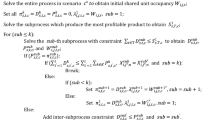Abstract
In the process industries, final products arise from chemical and physical transformations of materials on processing units. In batch production mode, the total requirements for intermediate and final products are divided into individual batches. To produce a batch, at first the input materials are loaded into a processing unit. Then a transformation process, called a task, is performed, and finally the output products are unloaded from the processing unit. Typically, a plant is operated in batch production mode when a large number of different products are processed on multi-purpose equipment. That is why we consider multi-purpose processing units, which can operate different tasks. Symmetrically, a task may be executed on different processing units, in which case the duration of the task may depend on the processing unit used. For a practical example of a multi-purpose batch production plant we refer to the case study presented by Kallrath (2002).
Access this chapter
Tax calculation will be finalised at checkout
Purchases are for personal use only
Preview
Unable to display preview. Download preview PDF.
Similar content being viewed by others
References
Blömer F, Günther HO (1998) Scheduling of a multi-product batch process in the chemical industry. Computers in Industry 36:245–259
Brucker P, Hurink J (2000) Solving a chemical batch scheduling problem by local search. Annals of Operations Research 96:17–36
Castro P, Barbosa-Póvoa AP, Matos H (2001) An improved RTN continuous-time formulation for the short-term scheduling of multipurpose batch plants. Industrial & Engineering Chemistry Research 40:2059–2068
Gentner K (2005) Dekompositionsverfahren für die ressourcenbe-schränkte Projektplanung. Shaker Verlag, Aachen
Gentner K, Neumann K, Schwindt C, Trautmann N (2004) Batch production scheduling in the process industries. In: Leung JYT (ed.) Handbook of Scheduling: Algorithms, Models, and Performance Analysis. CRC Press, Boca Raton, pp. 48/1–48/21
Ierapetritou MG, Floudas CA (1998) Effective continuous-time formulation for short-term scheduling. 1. Multipurpose batch processes, Industrial & Engineering Chemistry Research 37:4341–4359
Kallrath J (2002) Planning and scheduling in the process industry. OR Spectrum 24:219–250
Kondili E, Pantelides CC, Sargent RWH (1993) A general algorithm for short-term scheduling of batch operations: I. MILP Formulation. Computers and Chemical Engineering 17:211–227
Maravelias CT, Grossmann IE (2004) A hybrid MILP/CP decomposition approach for the continuous time scheduling of multipurpose batch plants. Computers and Chemical Engineering 28:1921–1949
Neumann K, Schwindt C (2002) Project scheduling with inventory constraints. Mathematical Methods of Operations Research 56:513–533
Neumann K, Schwindt C, Trautmann N (2002) Advanced production scheduling for batch plants in process industries. OR Spectrum 24:251–279
Neumann K, Schwindt C, Zimmermann J (2003) Project Scheduling with Time Windows and Scarce Resources. Springer, Berlin
Schwindt C, Trautmann N (2004) A priority-rule based method for batch production scheduling in the process industries. In: Ahr D, Fahrion R, Oswald M, Reinelt G (eds) Operations Research Proceedings 2003. Springer, Berlin, pp. 111–118
Trautmann N (2005) Operative Planung der Chargenproduktion. Deutscher Universitäts-Verlag, Wiesbaden
Author information
Authors and Affiliations
Editor information
Rights and permissions
Copyright information
© 2006 Deutscher Universitäts-Verlag/GWV Fachverlage GmbH, Wiesbaden
About this chapter
Cite this chapter
Schwindt, C., Trautmann, N. (2006). A Cyclic Approach to Large-Scale Short-Term Planning of Multipurpose Batch Plants. In: Morlock, M., Schwindt, C., Trautmann, N., Zimmermann, J. (eds) Perspectives on Operations Research. DUV. https://doi.org/10.1007/978-3-8350-9064-4_13
Download citation
DOI: https://doi.org/10.1007/978-3-8350-9064-4_13
Publisher Name: DUV
Print ISBN: 978-3-8350-0234-0
Online ISBN: 978-3-8350-9064-4
eBook Packages: Business and EconomicsBusiness and Management (R0)




